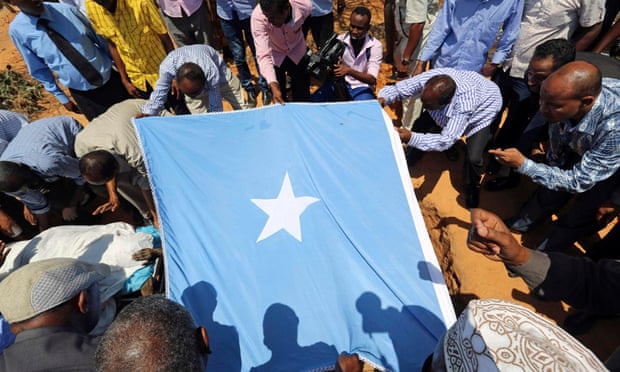Propaganda film is Somali group’s attempt to attract extremists and headlines again as Isis and Boko Haram raise stakes in terror recruitment and coverage
Mourners bury the Somali MP Abdullahi Qayad Bare, who was shot dead in Mogadishu by al-Shabaab gunmen in February. Photograph: Feisal Omar/Reuters
The slickly produced 77-minute film, posted online on Saturday, calls for strikes on Oxford Street and two Westfield malls in London, the Mall of America in Minnesota and Canada’s West Edmonton mall. “Westgate was just the beginning,” it proclaims, invoking what might cynically be described as al-Shabaab’s greatest hit: the siege of the Westgate mall in Nairobi, Kenya, in which 67 people were killed by four gunmen.But that was September 2013 and a great deal has happened since then. Isis has overrun swaths of Iraq and Syria, and produced macabre videos tailored to the modern media cycle. Boko Haram has rampaged through northern Nigeria and stolen headlines with the kidnapping of 276 schoolgirls in Chibok. Islamist gunmen have stunned the world by attacking a satirical magazine in Paris, killing 17 people over three days.
In the perverse battle for eyeballs and retweets, al-Shabaab’s PR department has been outwitted by its murderous rivals, while it has been losing territory after a hammering by American drones and African soldiers. Last September its leader, Ahmed Abdi Godane, was killed in a US air strike, while his successor, Ahmad Umar, has so far failed to establish a similarly high profile. There are two ways for al-Shabaab, an affiliate of al-Qaida, to put itself back on the global agenda. One was seen last Friday with the suicide bombing of a hotel in Mogadishu, killing 25 people, injuring more than 40 and deliberately denting hopes that the capital now has unstoppable momentum with new businesses, a construction boom and a returning diaspora.





























